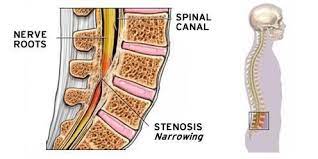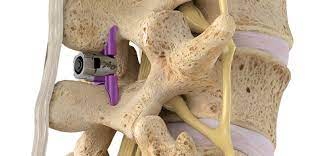What is
Spinal Stenosis
The spinal canal is the passageway where the spinal cord and nerve roots reside. Spinal stenosis results when the canal is narrowed. The narrowing may result from disc protrusions or herniations, thickening of the ligaments within the canal, movement of the vertebral bodies or osteophytes (bone spurs) growing into the canal. It is not possible to predict whether an individual will develop spinal stenosis. It does not have a predisposition for any sex, race or ethnicity. Spinal stenosis can be congenital, meaning present at birth. Acquired spinal stenosis is more common and generally affects people 60 or more years of age. Spinal stenosis may affect the cervical or lumbar spine. Symptoms include nerve compression leading to persistent pain in the buttocks, limping, lack of feeling in the extremities, or loss of bladder or bowel control. Often, patients have difficulty walking even relatively short distances because of leg symptoms of pain or weakness. This typically resolves with a brief period of rest or leaning forward, such as while walking with a shopping cart.

What are the Symptoms of Spinal Stenosis?
The primary symptom of spinal stenosis in the lumbar spine is pain, weakness, or other sensations in one or both legs worsened by walking activity. Stenosis can cause difficulty walking even relatively short distances, but this problem is typically improved with a brief rest. In the cervical spine, pain or numbness radiates into the arms and hands.
How do you Describe Spinal Stenosis?
The spinal canal is the passageway where the spinal cord and nerve roots reside. Spinal stenosis results when the canal is narrowed. The narrowing may result from disc protrusions or herniations, thickening of the ligaments within the canal, movement of the vertebral bodies or osteophytes (bone spurs) growing into the canal.
How do you Screen and Diagnose Spinal Stenosis?

Your physician will perform a physical examination. Imaging studies such as an MRI, CT scan or myelogram may also be ordered to help make the diagnosis. If the doctor thinks you have nerve damage, an electromyography (EMG) may be needed. This exam measures the effectiveness of your nerves to conduct signals.
Non-surgical options include medication, physical therapy, aerobic conditioning and epidural injections. Indications for surgery include pain that fails to improve satisfactorily with non-surgical treatment. Surgical treatment generally consists of spinal decompression to enlarge the spinal canal and relieve the pressure on the spinal cord or nerve roots. Fusion or interlaminar stabilization may be required if there is instability, or if decompression could potentially lead to instability. It is important to discuss treatment options with your doctor in deciding which treatment, if any, may be best for you.
What are the Treatments for Spinal Stenosis?

Request An APPOITMENT
Fell free to contact us with any questions or concern regarding Back/Neck pain.